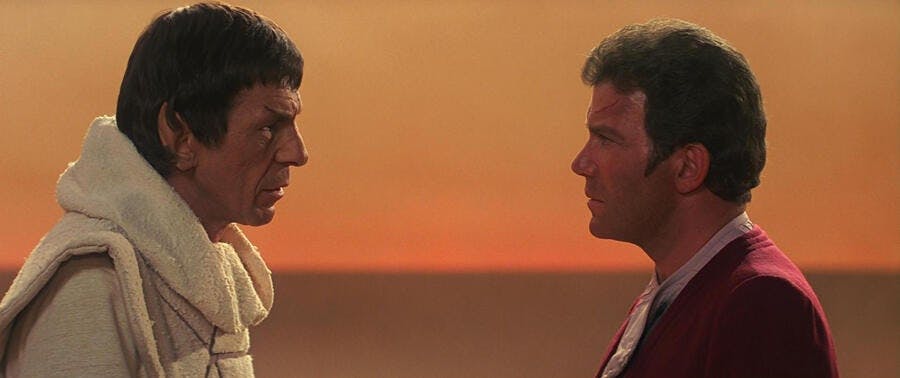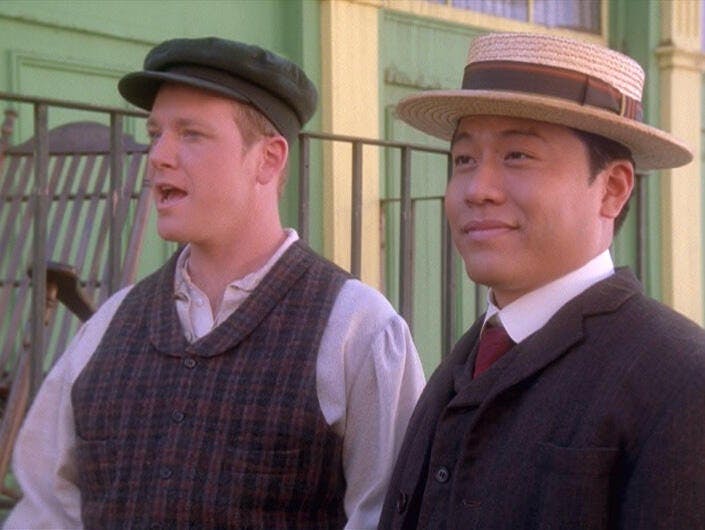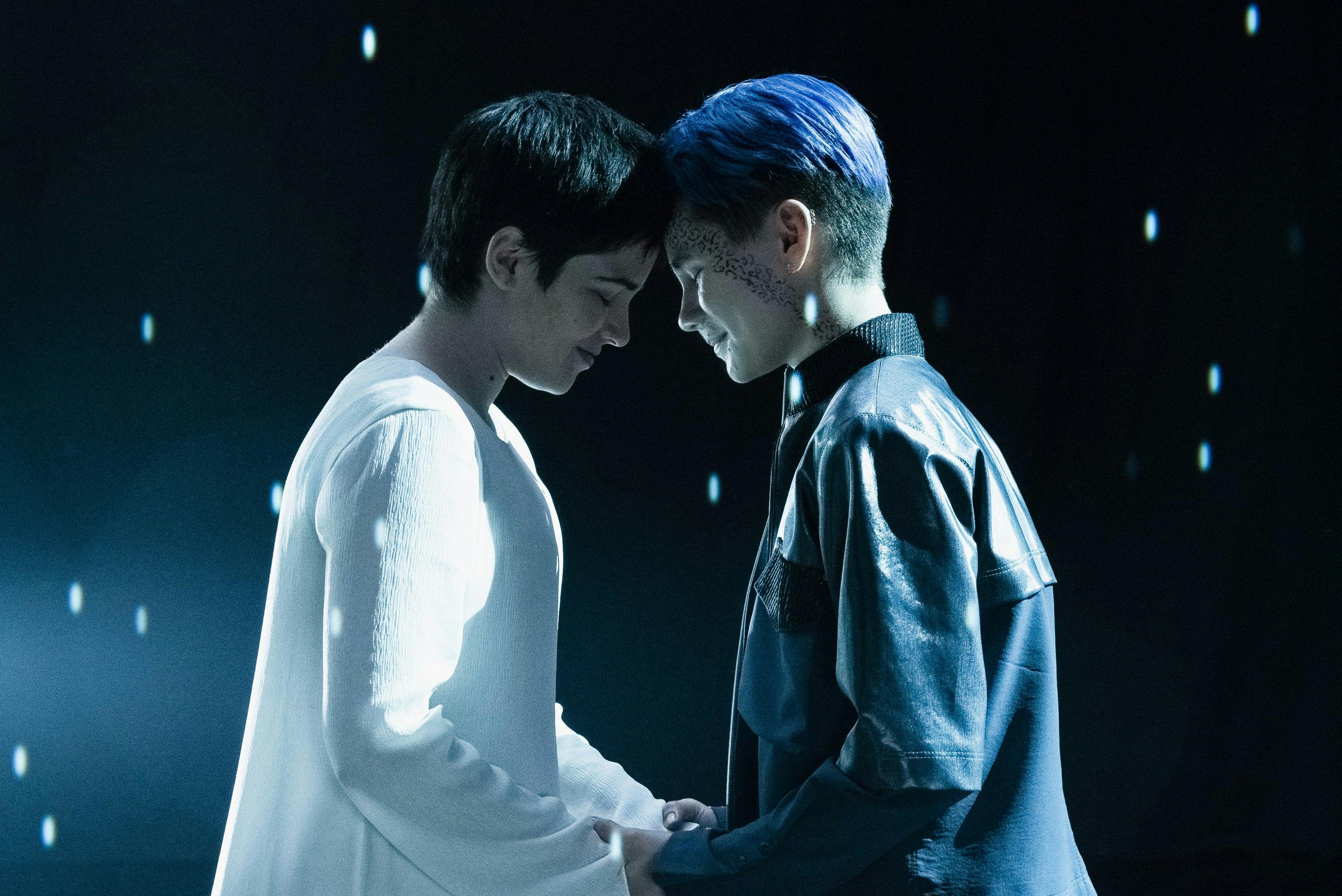Published Jan 13, 2025
The Needs of the Few: Queering the Canon
'Diversity is a start, but it isn’t the finish line.'

StarTrek.com
My father says that you have been my friend. You came back for me."
"You would have done the same for me."
"Why would you do this?"
"Because the needs of the one… outweigh the needs of the many.
Spock and James T. Kirk, Star Trek III: The Search for Spock

Star Trek III: The Search for Spock
StarTrek.com
Star Trek has always been my anchor, my port, and my guiding light in a sea of science fiction franchises that have all too often lagged in representation.
As a little girl, I was friendless. While I was bullied in school, in part for being a nerd — a term I now proudly reclaim — no one understood me quite so well as my favorite Star Trek characters. Growing up, I saw myself mirrored in the various inhabitants of the starship Voyager, stranded and forced to reach for one another and lean on each other in ways other crews didn't need to rely upon.
Lieutenant Tom Paris was always a bit of a rebel and a rogue, and though he'd had a few rough patches, he always came through when a tight spot appeared or when a friend was in need. He took Harry Kim under his wing, and became best friends with the green ensign who was entirely unprepared for the realities of life marooned in the Delta Quadrant. Tom Paris, for the most part, took this in stride, and indeed saw it as a bit of an opportunity to reinvent himself. He returned to Earth a changed man and an upstanding Starfleet officer.

"Fair Haven"
startrek.com
He was and remains my favorite Star Trek pilot. Even Wesley Crusher, a brilliant boy who was a Renaissance man at heart in a time when such a wide array of gifts often went under-appreciated, could not hold a candle to Tom Paris in my mind. The only problem was that Tom Paris and Wesley Crusher were both aggressively heterosexual. I knew I was queer from an early age, like many in the LGBTQIA+, and I wanted and needed to see queer representation in Star Trek.
Star Trek's first queer kiss graced our screens in 1995, during Season 4 of Nine in the episode "." It is a beautiful kiss, and the episode has aged well, both as social commentary and as a narrative in its own right, but it was, in the end, a single kiss.

"Rejoined"
StarTrek.com
I needed to see myself on the screen, but I saw the same cis- and heteronormative, patriarchal tropes and themes that I found problematic in my daily 21st Century life, still writ large on 24th Century faces and relationships.
The LGBTQIA+ population indeed represents a smaller portion of our society than straight and cisgender individuals, but the needs of the few sometimes outweigh the needs of the many.
My desperate, unspoken, ill-formed desire to see myself on the screen mirrors the need of every LGBTQIA+ fan to see themselves represented in Star Trek, that paragon of speculative fiction. This is a case where the needs of these few can and should outweigh the need of the many. The need to toe the line and maintain the status quo and the need to stay stationary and stand as a bulwark against progress have always been antithetical to everything Star Trek stands for.

"Forget Me Not"
StarTrek.com
We must ask ourselves — isn't the need of LGBTQIA+ children to grow up with queer role models that aren't token characters and queer love stories that aren't one-off episodes greater than the need of gatekeepers and bigots to remain isolated in an ever-shrinking bubble?
The purpose of Star Trek is to strive, to imagine, to explore, and to push the boundaries of what is possible. has made great strides in representation and inclusivity, particularly of queer, non-binary, and transgender characters. I have been overjoyed to see a canon gay couple in the form of Paul Stamets and Hugh Culber, whose love for one another proved to be stronger than death itself. I love Adira Tal, the first non-binary character with regular appearances on the show, and their transgender boyfriend, Gray Tal, for whom love also defied the limits of the probable.
In the Season 1 Discovery episode "Into the Forest I Go," Dr. Culber and Lieutenant Stamets share a deep and passionate kiss, meeting one another halfway as Paul arrives in Engineering. Stamets cradles his lover's face in his hands; Dr. Culber's hands hover on the other's waist, and they stand, holding each other, for a few moments afterward. It's a kiss that adds layers of meaning to the scene by painting a vivid and vibrant picture of the relationship between the two characters. The kiss speaks to their history together, and to their shared vision of a future they are forging by each other's side.

"If Memory Serves"
StarTrek.com
Their relationship has its fair share of ups and downs — but the same can be said of any lasting relationship. The love they share is wholesome, and though Hugh experiences second thoughts after his return from the mycelial network, he eventually comes back to Paul. Amongst the chaos of the Season 2 finale's fearsome battle to save the future, Hugh tells Paul, "You’re my home."
For the longest time, watching and , I wanted to see myself on the screen. I wanted a Star Trek where love — all love, no matter the gender identity and expression of those involved — was transcendental, universal, beautiful, tragic at times, but above all, hopeful. Discovery provided us with a glimpse of that. It gave us two nuanced, three-dimensional love stories between characters who would have been relegated to a single episode now and again in earlier Star Trek shows.
Make no mistake; Star Trek has always been ahead of the curve, and it remains so today. That is the very essence of the show; it boldly goes where no one has gone before, and it does so unapologetically and without concern for what those who fall on the wrong side of progress will think. More than 70 nations still condemn and criminalize private, consensual, same-sex relations. It is my hope that these laws and the institutions that uphold them will be remembered in the 24th Century as primitive bygones of an unenlightened age.
Star Trek gives us room to dream of a more inclusive future, where healthy, thriving relationships, platonic and romantic, queer and otherwise, serve as a humanizing element in the cold vastness of space. Star Trek teaches us that love can be as vast a nebula, that it can span star systems and cross universes and defy the known laws of science. In Star Trek, the most powerful force of nature is love.
When we imagine a more equitable future, diversity is a start, but it isn't the finish line. Our vision must also include acceptance of and equity for historically marginalized groups. The future Star Trek encourages us to build is one where kindness trumps cruelty, and diplomacy and open communication settle disputes between rival factions.
This vision of the future is no mere fantasy, no simple science fiction. It is a reality we are called upon to create, together. LGBTQIA+ rights are human rights, and ultimately, Star Trek is an exploration of what is possible, when we reach for those furthest from us with love in our hearts and words of understanding on our lips.





